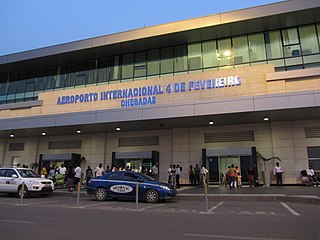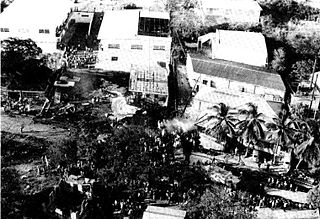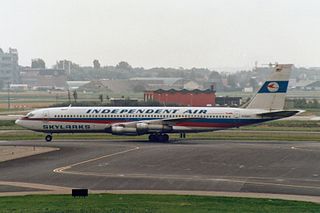
Quatro de Fevereiro International Airport, is the main international airport of Angola. It is located in the southern part of the capital Luanda, situated in the Luanda Province. Quatro de Fevereiro means 4 February, which is an important national holiday in Angola, marking the start of the armed struggle against the Portuguese colonial regime on 4 February 1961. In 2009, about 1.8 million passengers were counted.

Eastern Air Lines Flight 66 was a regularly scheduled flight from New Orleans to New York City that crashed on June 24, 1975 while on approach to New York's John F. Kennedy International Airport, killing 113 of the 124 people on board. The crash was determined to be caused by wind shear caused by a microburst, but the failure of the airport and the flight crew to recognize the severe weather hazard was also a contributing factor.

American Airlines Flight 625, a Boeing 727-100, crashed at St. Thomas, U.S. Virgin Islands on April 27, 1976, while on a domestic scheduled passenger flight originating at T. F. Green Airport in Rhode Island and ending at Saint Thomas, United States Virgin Islands, with an intermediate stop at John F. Kennedy International Airport. 37 out of the 88 passengers on board died in the accident.

Southwest Airlines Flight 1248 was a scheduled passenger flight from Baltimore, Maryland, to Chicago, Illinois, continuing on to Salt Lake City, Utah, and then to Las Vegas, Nevada. On December 8, 2005, the airplane slid off a runway at Chicago-Midway while landing in a snowstorm and crashed into automobile traffic, killing a six-year-old boy.

Trans World Airlines Flight 514, registration N54328, was a Boeing 727-231 en route from Indianapolis, Indiana and Columbus, Ohio to Washington Dulles International that crashed into Mount Weather, Virginia, on Sunday, December 1, 1974. All 92 aboard, 85 passengers and seven crew members, were killed. In stormy conditions late in the morning, the aircraft was in controlled flight and impacted a low mountain 25 nautical miles northwest of its revised destination.

United Airlines Flight 227 (N7030U), a scheduled passenger flight from LaGuardia Airport New York City to San Francisco International Airport, California, crashed short of the runway while attempting a scheduled landing at Salt Lake City International Airport, Utah, on Thursday, November 11, 1965.

American Airlines Flight 383 was a nonstop flight from New York City to Cincinnati on November 8, 1965. The aircraft was a Boeing 727, with 57 passengers, and 5 crew on board. The aircraft crashed on final approach to the Cincinnati/Northern Kentucky International Airport located in Hebron, Kentucky, United States. Only three passengers and one flight attendant survived the crash.

Madeira Airport, informally Funchal Airport, formally Santa Catarina Airport and officially Cristiano Ronaldo International Airport, is an international airport in the civil parish of Santa Cruz in the Portuguese archipelago and autonomous region of Madeira. The airport is located 13.2 km (8.2 mi) east-northeast of the regional capital, Funchal, after which it is sometimes informally named. It mostly hosts flights to European metropolitan destinations due to Madeira's importance as a leisure destination, and is pivotal in the movement of cargo in and out of the archipelago of Madeira. It is the fourth-busiest airport in Portugal. The airport is named after Madeiran native Cristiano Ronaldo, who is widely considered to be one of the greatest footballers of all time. During its renaming ceremony in 2017, the airport drew media notoriety for an infamous bust of Ronaldo unveiled at the ceremony, now replaced.

Southwest Airlines Flight 1455 was a scheduled passenger flight from McCarran International Airport, Las Vegas, Nevada to Burbank-Glendale-Pasadena Airport, Burbank, California, that overran the runway during landing on March 5, 2000. The aircraft, a Boeing 737-3T5, registration N668SW, came to rest on a city street adjacent to a gas station. The National Transportation Safety Board found that the incident was due to the pilots attempting to land with excessive speed. They also found that the air traffic controller placed them in a position from which their only option was a go around. Two of the passengers were seriously injured, and there were many minor injuries. As a result of the incident, the airport installed an Engineered Materials Arrestor System (EMAS) at the east end of the incident runway. The aircraft was written off, making the incident the 10th hull loss of a Boeing 737-300. This was the first major accident in the airline's 29-year history.

On 8 February 1989, Independent Air Flight 1851, a Boeing 707 on an American charter flight from Bergamo, Italy to Punta Cana, Dominican Republic, struck Pico Alto while on approach to Santa Maria Airport in the Azores for a scheduled stopover. The aircraft was destroyed, with the loss of all 144 people on board, resulting in the deadliest plane crash in Portugal's history. All of the passengers on board were Italian and all of the crew were Americans. The crash is also known as "The disaster of the Azores".

The Madeira islands and Funchal have an extensive public transportation system. Travel between the two main islands is by plane or by ferries, the latter also allowing for the transportation of vehicles. Visiting the interior of the islands is now easy, due to major road developments, known as the Vias rápidas, on the islands during Portugal's economic boom.

SA de Transport Aérien Flight 730 was a Sud Aviation SE-210 Caravelle 10R aircraft, registered as HB-ICK, that crashed on approach to Funchal Airport, Madeira, on December 18, 1977.

TAME Flight 120 was a Boeing 727-134 airliner, registration HC-BLF, named El Oro, operating as a scheduled international passenger flight between Quito, Ecuador and Cali, Colombia, with a scheduled stopover at the Ecuadorian border town of Tulcán. The aircraft crashed while on approach to Tulcán's Teniente Coronel Luis A. Mantilla International Airport on January 28, 2002. The pilot flew the approach incorrectly in reportedly foggy conditions, and the aircraft crashed into the side of the Cumbal Volcano, located near Ipiales, Colombia, at 10:23 in the morning. All passengers and crew were killed in the crash.
TAP Air Portugal is the state-owned flag carrier airline of Portugal, headquartered at Lisbon Airport which also serves as its hub. TAP – Transportes Aéreos Portugueses – has been a member of the Star Alliance since 2005 and operates on average 2,500 flights a week to 90 destinations in 34 countries worldwide. The company has a fleet of 100 aircraft, all of which are manufactured by Airbus with the exception of 22 made by Embraer and ATR, operating on behalf of the regional airline TAP Express.

Iberia Flight 610 was a scheduled domestic passenger flight from Madrid to Bilbao, Spain. On 19 February 1985, a Boeing 727-200 operating the flight crashed into a television antenna on the summit of Mount Oiz in Biscay near Bilbao. All 141 passengers and 7 crew on board died. The crash is the deadliest aviation disaster in both the Basque Country and Iberia history.

Turkish Airlines Flight 452 was a scheduled domestic passenger flight from Istanbul Atatürk Airport to Antalya Airport, Turkey. On 19 September 1976, the Boeing 727-200 operating the flight struck a slope of a hill at Karatepe in Isparta Province, 60 mi (97 km) north of the destination airport due to a pilot error on approach resulting in the death of all 154 people on board. To date, the crash is the deadliest aviation accident to occur in Turkey.

Allied Air Flight 111 was a cargo flight operated by Lagos-based cargo airliner Allied Air, flying from Lagos, Nigeria to Accra, Ghana. The flight was operated with a Boeing 727 cargo aircraft. On 2 June 2012, the aircraft crashed on landing at Kotoka International Airport, killing twelve people on the ground.

FedEx Express Flight 1478 was a scheduled domestic cargo flight from Memphis International Airport to Tallahassee International Airport. On July 26, 2002, the Boeing 727-232F aircraft flying this route crashed during landing at Tallahassee. All three flight crew members survived the accident with serious injuries, but the aircraft was destroyed.

















